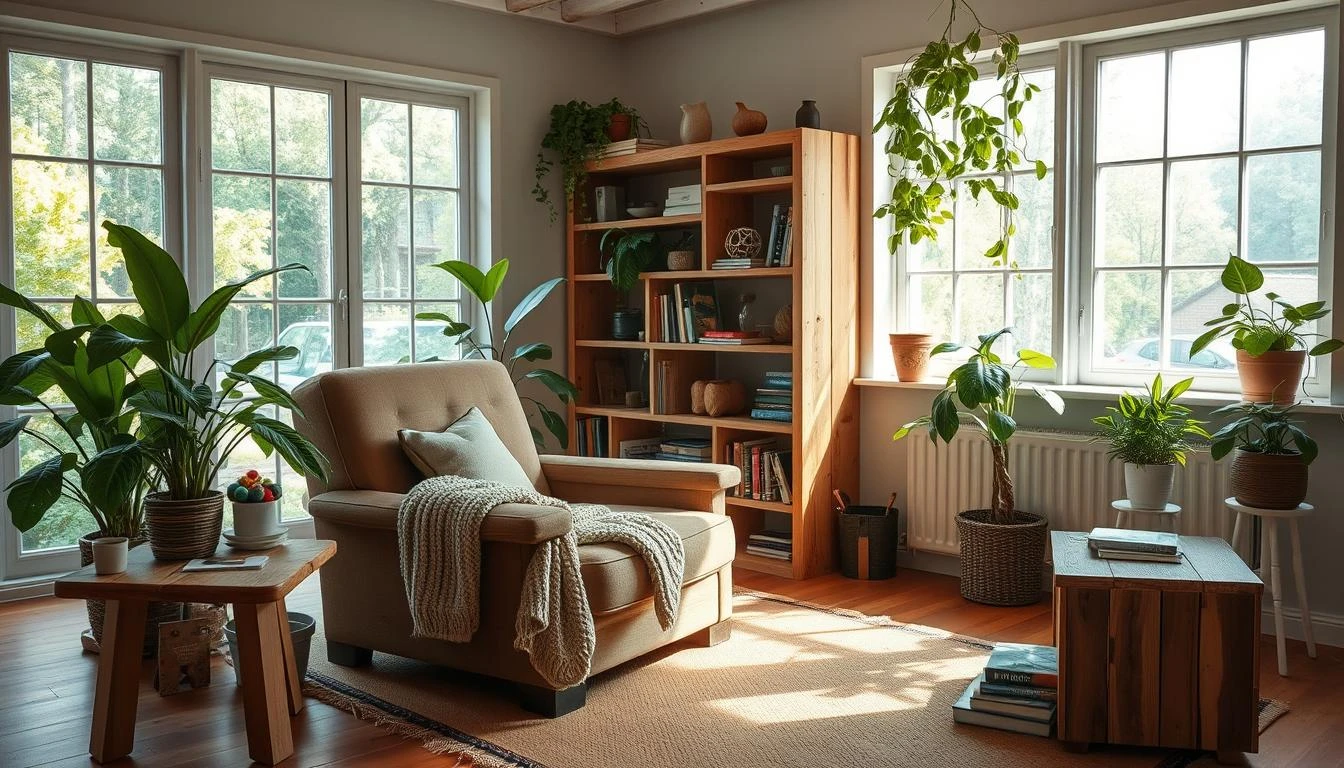
Making your home eco-friendly is simpler than you might think. By breathing new life into old furniture, you can craft a unique, sustainable decor. This not only helps the planet but also makes your space truly yours.
Upcycling is a creative method to turn old items into useful pieces. It cuts down on waste and supports sustainability. For example, an old dresser can become a chic kitchen island. Or, a vintage door can be repurposed as a coffee table, making your decor stand out.
Key Takeaways
- Upcycling old furniture reduces waste and promotes eco-friendliness.
- Sustainable decor adds a personal touch to your home.
- Creative upcycling can transform discarded items into functional pieces.
- You can create unique and functional pieces for your home.
- Eco-friendly home decor is both stylish and environmentally beneficial.
The Environmental and Economic Benefits of Furniture Upcycling
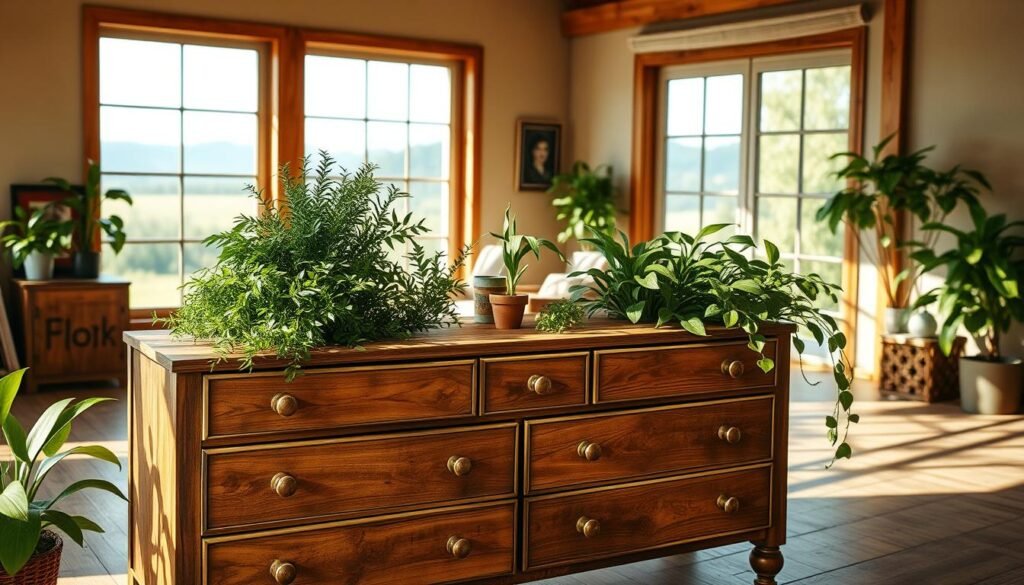
Upcycling old furniture has many environmental and economic benefits. It helps you live more sustainably by giving old items a new life.
One big environmental benefit is less waste. Upcycling keeps furniture out of landfills, reducing waste’s environmental harm. It also saves resources by cutting down on the need for new materials.
There are also economic benefits. Upcycling can save you money by using items you’d throw away or buy new. It also boosts local economies by supporting thrift stores and hardware stores.
Upcycling also makes your home unique and personal. It’s a creative way to make your space special while caring for the planet.
Adding furniture upcycling to your life benefits the environment and your wallet. It’s a smart choice for a greener, more fulfilling life.
Essential Tools and Materials for Upcycling Old Furniture for Sustainable Decor
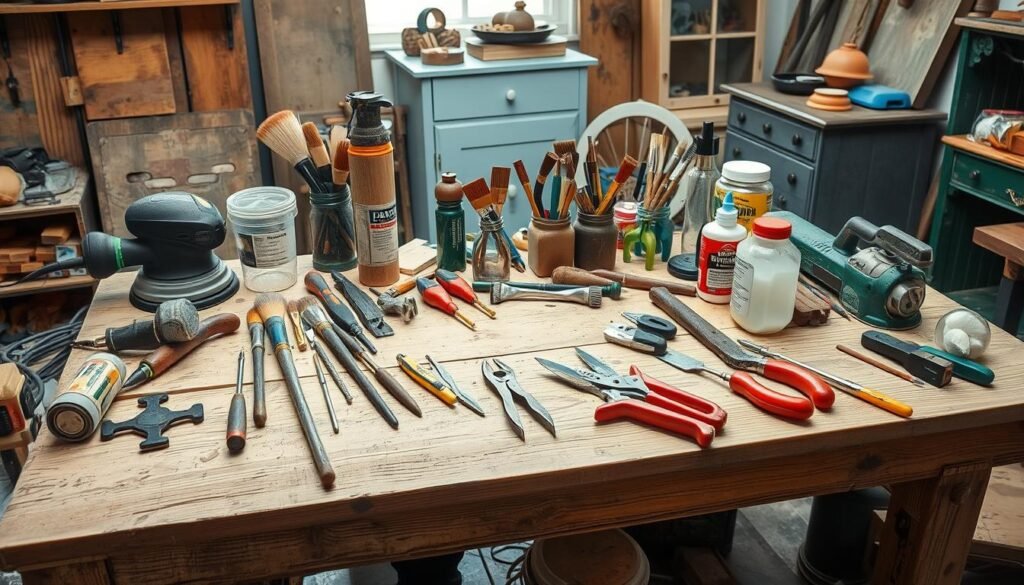
Upcycling old furniture starts with the right tools and materials. These make the process fun and safe. You’ll need various tools and eco-friendly materials to create unique, functional pieces.
Must-Have Hand Tools
Hand tools are key for upcycling. You’ll need a hammer, tape measure, square, level, and screwdrivers. Chisels and hand saws are also crucial for removing old finishes and making cuts. Don’t forget clamps to hold pieces together while gluing.
Power Tools That Make the Job Easier
Power tools speed up upcycling. A cordless drill/driver is essential for drilling and screwing. Use a jigsaw or circular saw for cutting wood, and a sander for smoothing surfaces. A rotary sander is great for efficient sanding.
Safety is crucial when upcycling. Always wear safety glasses, a dust mask, and gloves. A workshop safety kit offers extra protection against accidents.
Low-VOC and Zero-VOC Options
Choose low-VOC or zero-VOC finishes to reduce environmental impact. Opt for eco-friendly paints and stains labeled as low-VOC or zero-VOC.
Natural Waxes and Oils
Natural waxes and oils are great alternatives to synthetic finishes. Beeswax and linseed oil protect and enhance wood. They are non-toxic and durable.
Homemade Finishing Solutions
DIY finishing solutions are fun and creative. Mixing your own stains and finishes with natural ingredients is rewarding. It lets you customize your upcycled furniture.
With the right tools and materials, you can upcycle old furniture into beautiful, functional pieces. These contribute to a more sustainable home decor.
Preparing Your Furniture for the Upcycling Process
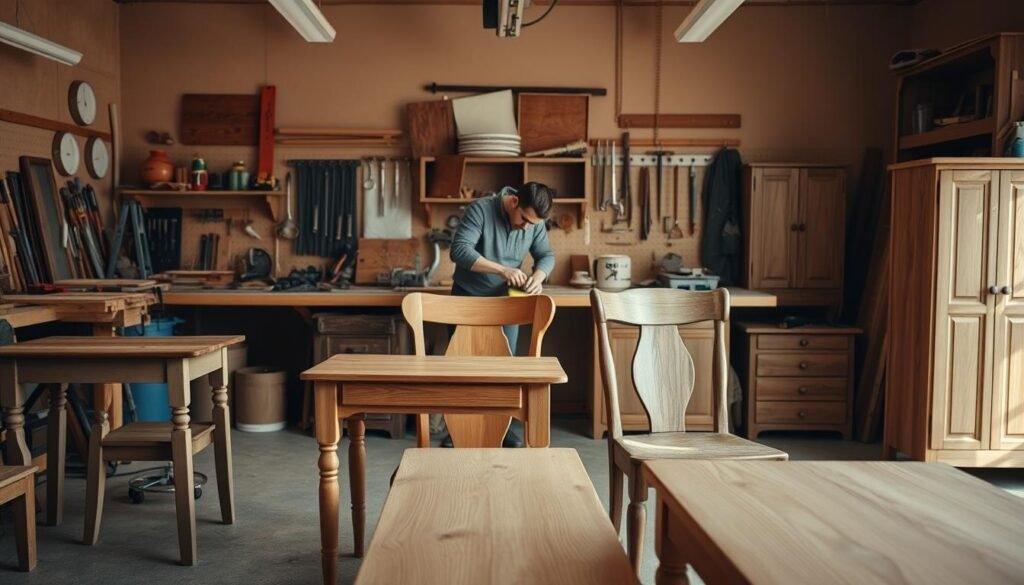
To give old furniture a new life, you need to prepare it first. This step is key to a successful and fun project.
Wood Furniture Preparation
Start with wood furniture by cleaning it well. This removes dirt and grime. Then, sand the surface to smooth it out and remove old finishes.
For metal furniture, clean the surface with a wire brush. This removes rust and dirt. If needed, apply a rust converter and prime the metal to stop rust.
Make sure all bolts and screws are tight.
Upholstered Furniture Preparation
Begin with upholstered furniture by taking off the old upholstery. Check the frame for damage. Clean the frame well and fix any issues before adding new upholstery.
By following these steps, you’re ready for a successful upcycling project.
Popular Furniture Upcycling Techniques for Beginners
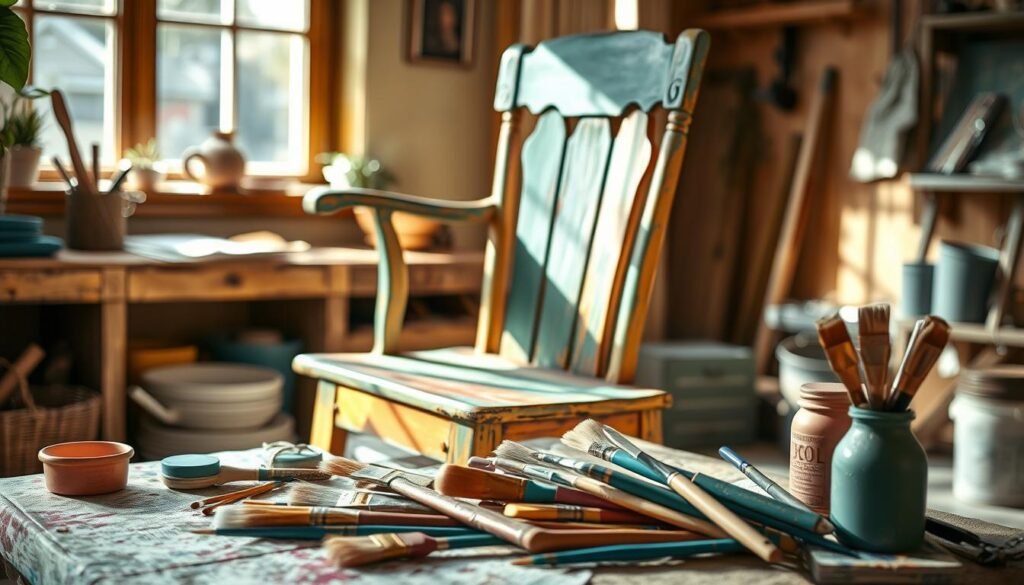
Starting with furniture upcycling is exciting. It’s a mix of creativity and being green. You can turn old furniture into something new and useful for your home.
Chalk painting is a favorite for beginners. It makes furniture look vintage or shabby chic easily. Let’s look at how to chalk paint and get a cool, distressed look.
Step-by-Step Chalk Painting Process
You need chalk paint, a brush, and wax to start. Clean your furniture first. Then, paint it with smooth strokes. Wait for it to dry before adding more paint if needed.
After the paint dries, apply wax for protection and shine. Use a cloth to buff the wax. This makes the paint look better.
To add a vintage look, distress the furniture. Use sandpaper on edges and surfaces. Focus on corners and details.
After distressing, apply clear wax. For a deeper look, use dark wax on distressed areas. Buff it with a cloth for a smooth finish.
Learning these upcycling techniques lets you make old furniture unique. Chalk painting, distressing, and waxing are key. Remember, it’s all about trying new things and being patient.
Creative Transformation Ideas for Different Types of Furniture
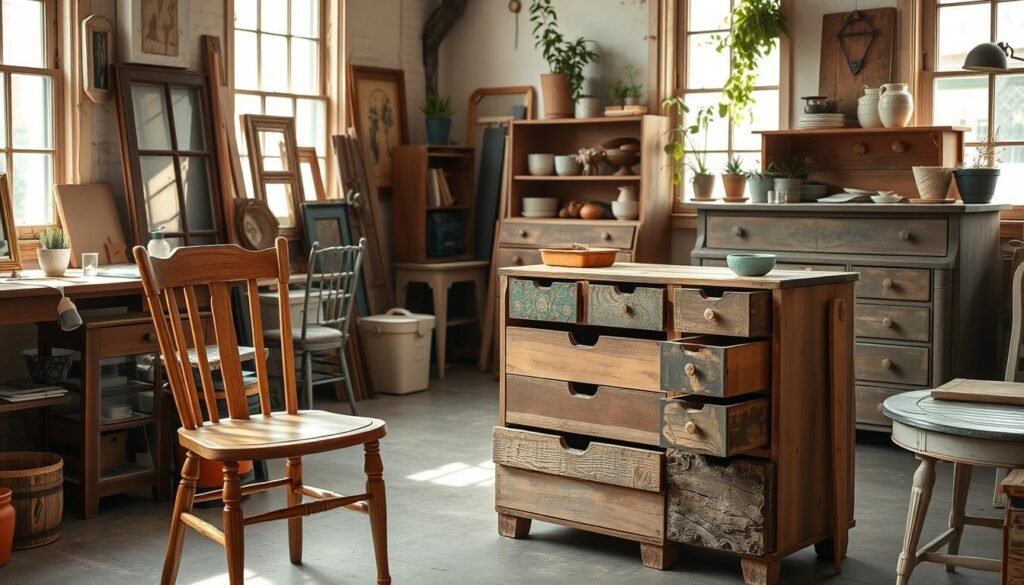
With a little creativity, you can give old furniture a new life. This makes your home more unique and sustainable.
Furniture transformation works on many pieces. From kitchen islands and buffets to media centers and entertainment units. Let’s dive into some creative ideas for these.
Kitchen Islands and Buffets
Kitchen islands and buffets are key in the kitchen. You can turn an old dresser or kitchen cart into a stylish island. Just add a butcher block or marble top. Decorative hardware or a fresh coat of paint can make it pop.
Buffets can get a new look from an old sideboard or vintage cabinet. Refinish it, swap out the knobs, or add a glass top for a modern vibe. Underlighting adds warmth.
Turning old furniture into media centers or entertainment units is fun. Use an old armoire, bookcase, or TV stand. Add shelves, drawers, or compartments for your devices and accessories.
For a sleek look, paint it in a modern color or add metallic touches. LED lighting can make it futuristic. Upcycling an old unit into a modern media center is eco-friendly and stylish.
These creative transformation ideas can make outdated furniture functional and stylish. It shows off your personal taste.
Advanced Upcycling Projects for Experienced DIYers
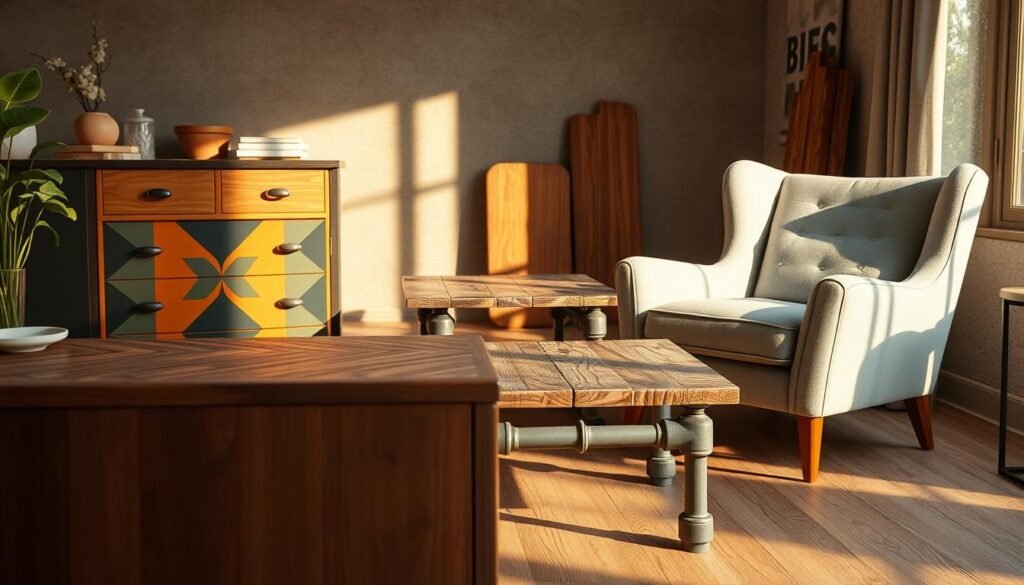
Take your DIY skills to the next level with advanced upcycling projects. These projects mix function with beauty. As an experienced DIYer, you’re ready for projects that test your creativity and skills.
Advanced upcycling turns old furniture into unique pieces. These pieces are not just useful but also spark conversations. One way to do this is by installing new hardware for a fresh look. Swapping out old knobs and handles for new ones can greatly improve a piece’s look.
Installing New Hardware for Updated Looks
Updating furniture hardware is easy, like swapping knobs, or complex, like making custom handles. This simple change can give your piece a modern or vintage look, depending on your choice.
Adding Decorative Moldings and Trim
Adding decorative moldings and trim is another technique. These elements can add elegance or whimsy, depending on the design. They can create intricate patterns or frame a piece, making it look more polished.
Incorporating glass, metal, or stone elements can also enhance your projects. For example, adding a glass top to a wooden table or using metal accents can give it a modern feel. Stone elements, like marble or granite, can add a luxurious touch.
Cribs to Benches and Desks
Transforming old cribs into benches or desks is a creative idea. With imagination and the right tools, you can give a crib a new purpose in your home.
Dressers to Kitchen Islands
Converting old dressers into kitchen islands is another innovative project. It not only breathes new life into an old piece but also adds storage and counter space in your kitchen.
Doors to Tables and Headboards
Old doors can be turned into unique tables or headboards. With creativity, you can transform discarded doors into beautiful, functional pieces that add character to any room.
By using these advanced upcycling techniques, you can create unique pieces that show your personal style and creativity. Whether it’s updating hardware, adding decorative elements, or repurposing entire pieces, the possibilities are endless.
Showcasing Stunning Before and After Furniture Transformations
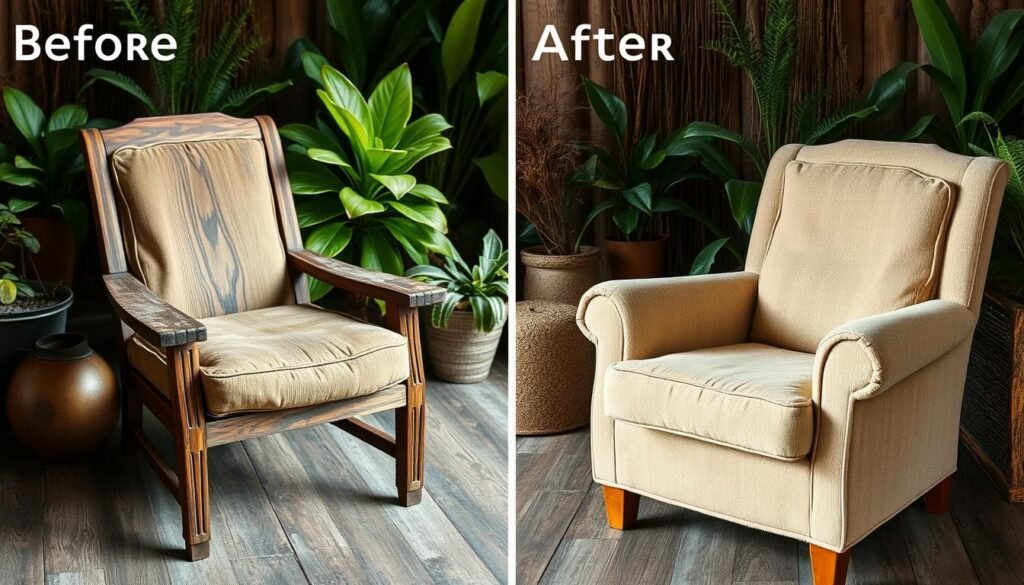
See the magic of upcycling in these stunning before-and-after furniture makeovers. Upcycling is more than just painting old furniture. It’s about making it look brand new again.
Take an old, worn-out armchair and turn it into a stylish statement piece. Just add a fresh coat of paint and new upholstery. The possibilities are endless when it comes to upcycling, and the results are amazing.
An old wooden dresser can be sanded and refinished to shine like new. Adding new hardware gives it a modern look. These simple steps can change a piece’s whole look.
For example, an old pallet can become a unique coffee table. With creativity and basic DIY skills, you can make a one-of-a-kind piece. It adds character to your living room.
These makeovers show the power of upcycling. They also inspire you to create something beautiful from old furniture.
Where to Find Old Furniture Worth Upcycling
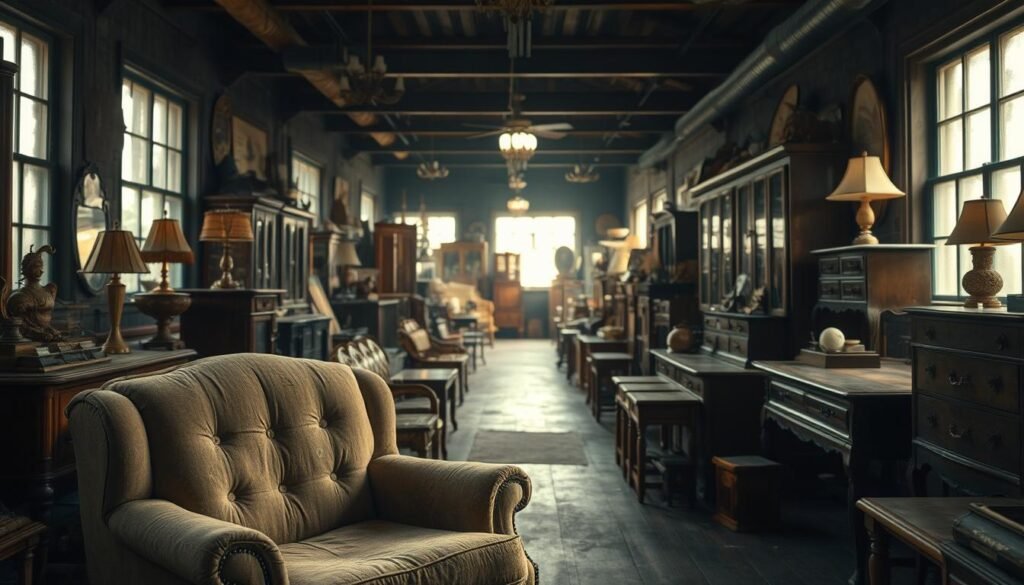
You can find unique furniture pieces to upcycle at many places. Thrift stores are a great starting point. They have gently used furniture that can be turned into beautiful items.
Local estate sales are also a good place to look. You’ll find a variety of furniture, from old to new, at lower prices. Look for sturdy items that can be made over with some creativity.
Online marketplaces make it easy to find old furniture. Sites like Craigslist and Facebook Marketplace are full of potential. Just make sure to check the furniture well before buying.
Auction houses and antique stores offer unique furniture too. While it might cost more, the quality and rarity are worth it.
Ask friends and family if they have old furniture to give away or sell. You can also watch for furniture left on the curb during clean-up days.
With patience and persistence, you’ll find the perfect piece to upcycle.
Conclusion: Embracing Sustainable Living Through Furniture Upcycling
Exploring furniture upcycling is a big step towards living greener. It gives old furniture a new lease on life. This not only cuts down on waste but also lets you express your style through unique pieces.
Keep exploring upcycling by trying new methods and materials. Show off your work and encourage others to live more sustainably. This way, you help grow a movement towards a greener world. Upcycling furniture is a simple yet powerful way to help the planet.
As you keep upcycling, you’ll find joy in making something new from something old. You’ll also help reduce your carbon footprint and support a sustainable culture. So, keep upcycling and let’s work together towards a greener future.
